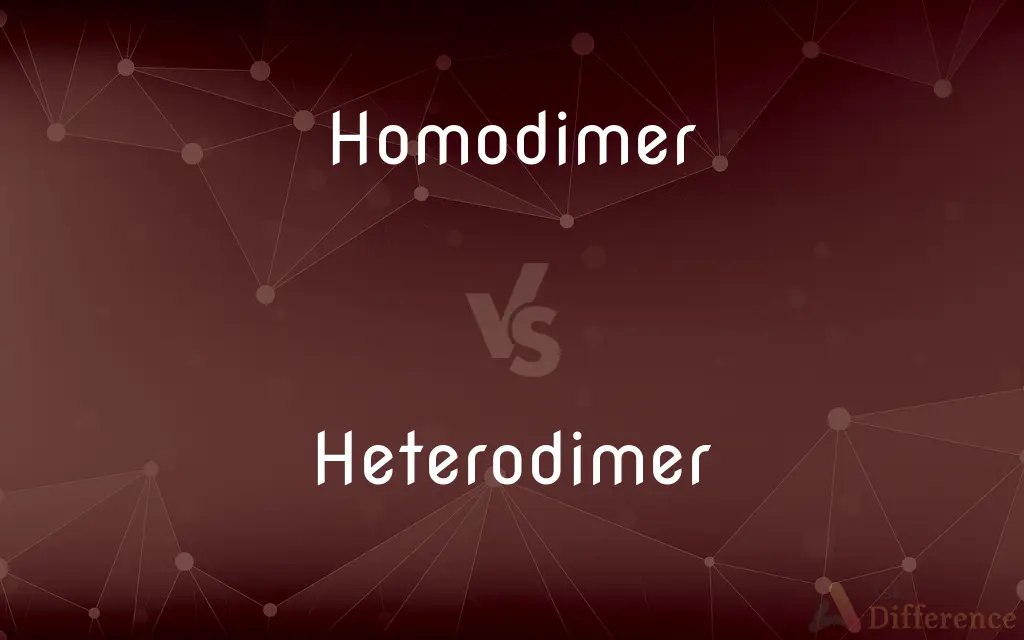Homodimer vs. Heterodimer — What's the Difference?
Edited by Tayyaba Rehman — By Maham Liaqat — Updated on April 16, 2024
Homodimers consist of two identical subunits, enhancing stability and function specificity; heterodimers, with two different subunits, offer diverse functionalities and regulatory mechanisms.

Difference Between Homodimer and Heterodimer
Table of Contents
ADVERTISEMENT
Key Differences
Homodimers are protein complexes formed by two identical protein molecules. Whereas heterodimers are composed of two different protein molecules, providing varied structural and functional characteristics.
In homodimers, the identical nature of the subunits often results in symmetrical interactions, on the other hand, heterodimers display asymmetrical interactions due to the diversity in their subunit compositions.
The formation of homodimers can be crucial for the stabilization of protein structure, whereas heterodimers often play key roles in signaling pathways and regulatory mechanisms within cells.
Homodimers may have a more predictable interaction interface due to the similarity between the subunits, whereas the interaction interface in heterodimers can be more complex, reflecting the unique features of each subunit.
Functionally, homodimers often enhance the same function by multimerization, whereas heterodimers can integrate different functionalities or regulatory mechanisms, expanding the versatility of protein functions.
ADVERTISEMENT
Comparison Chart
Subunit Composition
Composed of two identical protein subunits
Composed of two different protein subunits
Symmetry
Typically symmetrical due to identical subunits
Often asymmetrical due to diverse subunits
Functional Role
Enhances specific functions through redundancy
Integrates different functions for diverse roles
Structural Stability
Can provide enhanced stability
May offer specialized stability and flexibility
Biological Importance
Important in enzyme catalysis and structural support
Crucial in cell signaling and regulatory mechanisms
Compare with Definitions
Homodimer
Typically formed by self-association.
The enzyme hexokinase forms a homodimer to be fully functional.
Heterodimer
Offers flexibility and regulatory control.
The NF-κB heterodimer plays a key role in immune response modulation.
Homodimer
Enhances stability and function through redundancy.
The homodimer of the transcription factor NF-κB is crucial for DNA binding.
Heterodimer
Found in various signaling and regulatory proteins.
G-protein-coupled receptors often involve heterodimers.
Homodimer
A complex of two identical protein molecules.
The collagen homodimer is essential for maintaining the structural integrity of tissues.
Heterodimer
A complex of two different protein molecules.
The T cell receptor heterodimer is vital for antigen recognition.
Homodimer
A biological entity where two similar units bind together.
Hemoglobin acts as a homodimer in some lower organisms.
Heterodimer
Crucial in diverse cellular functions.
The heterodimer of retinoid X receptor and vitamin D receptor regulates gene expression.
Homodimer
Common in many structural proteins.
Keratin filaments in epithelial cells are homodimers.
Heterodimer
Forms through the association of two non-identical units.
Hormone receptors often function as heterodimers.
Homodimer
(chemistry) A dimer derived from two identical monomers
Heterodimer
A dimer, especially a biologically active one, derived from two or more different monomers
Common Curiosities
Why are homodimers important in biological systems?
Homodimers provide structural stability and enhance specific biological functions through redundancy.
How do heterodimers contribute to cellular functions?
Heterodimers facilitate diverse cellular functions by integrating different functionalities and regulatory mechanisms.
What is a heterodimer?
A heterodimer is a complex formed by two different protein molecules.
What is an example of a homodimer in human cells?
Hemoglobin in humans functions as a homodimer in certain conditions.
Can a protein form both homodimers and heterodimers?
Yes, some proteins can participate in both homodimer and heterodimer formations, depending on the cellular context and the presence of other proteins.
How do homodimers and heterodimers differ in their formation?
Homodimers form through self-association of identical units, while heterodimers require the interaction of different units.
What is a homodimer?
A homodimer is a complex formed by two identical protein molecules.
How do heterodimers interact with other cellular components?
Heterodimers often interact with diverse cellular components to mediate signaling pathways and regulatory mechanisms.
How do heterodimers affect gene regulation?
Heterodimers can regulate gene expression by combining different DNA-binding affinities and regulatory properties.
Can the disruption of homodimer formation lead to disease?
Yes, disruptions in homodimer formation can lead to diseases related to protein misfolding or loss of function.
What are the therapeutic implications of targeting heterodimers?
Targeting heterodimers in therapies can be crucial for diseases like cancer, where specific signaling pathways are disrupted.
What role do homodimers play in enzyme activity?
Homodimers can enhance enzyme catalysis by providing structural stability and functional redundancy.
Are homodimers more stable than heterodimers?
Homodimers often provide enhanced stability due to identical subunit interactions, but heterodimers can offer specialized stability.
What is an example of a heterodimer that plays a role in human disease?
The heterodimer of HER2 and HER3 is implicated in certain forms of cancer.
Why might a researcher choose to study heterodimers over homodimers?
Studying heterodimers can provide insights into complex regulatory mechanisms and potential therapeutic targets due to their diverse functionalities.
Share Your Discovery

Previous Comparison
Carnation vs. Marigold
Next Comparison
Anecdotally vs. AnecdotalAuthor Spotlight
Written by
Maham LiaqatEdited by
Tayyaba RehmanTayyaba Rehman is a distinguished writer, currently serving as a primary contributor to askdifference.com. As a researcher in semantics and etymology, Tayyaba's passion for the complexity of languages and their distinctions has found a perfect home on the platform. Tayyaba delves into the intricacies of language, distinguishing between commonly confused words and phrases, thereby providing clarity for readers worldwide.













































